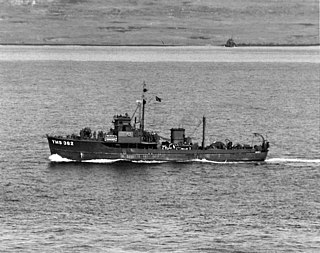
USS Pledge (AM-277) was an Admirable-class minesweeper built for the U.S. Navy during World War II. She was built to clear minefields in offshore waters, and served the Navy in the Atlantic Ocean and then was transferred to the North Pacific Ocean. She survived the world war and was awarded one battle star, but, during the Korean War, she struck a mine and was sunk. She received the Presidential Unit Citation for her Korean service.

USS Sprig (AM-384) was an Auk-class minesweeper acquired by the United States Navy for the dangerous task of removing mines from minefields laid in the water to prevent ships from passing.

USS Hornbill was a YMS-1-class minesweeper of the YMS-135 subclass built for the United States Navy during World War II. After World War II, she continued to be in use until the mid-1950s.

USS Lapwing was a YMS-1-class minesweeper of the YMS-135 subclass built for the United States Navy during World War II. She was named after the lapwing.

USS Lark was a YMS-1-class minesweeper of the YMS-135 subclass built for the United States Navy during World War II.

USS Merganser (AMS-26/AMCU-47/MHC-47) was a YMS-1-class minesweeper of the YMS-135 subclass built for the United States Navy during World War II.

USS Grouse (AMS-15/YMS-321) was a YMS-1-class minesweeper of the YMS-135 subclass built for the United States Navy during World War II.

USS Waxbill (MHC-50/AMCU-50/AMS-39/YMS-479/PCS-1456) was a YMS-1-class minesweeper of the YMS-446 subclass acquired by the U.S. Navy for the task of removing mines placed in the water to prevent ships from passing.

USS Hawk was a YMS-1-class minesweeper of the YMS-135 subclass built for the United States Navy during World War II.
USS Linnet (AMS-24/YMS-395) was a YMS-1-class minesweeper of the YMS-135 subclass built for the United States Navy during World War II.

USS Kite was a YMS-1-class minesweeper of the YMS-135 subclass built for the United States Navy during World War II.

USS Nightingale was a YMS-1-class minesweeper of the YMS-135 subclass acquired by the U.S. Navy for the dangerous task of removing mines from minefields laid in the water to prevent ships from passing.

USS Brambling (AMS-42/YMS-109) was a YMS-1-class auxiliary motor minesweeper acquired by the U.S. Navy for the task of removing mines from water that had been placed there to prevent ships from passing.

USS Ostrich was a YMS-1-class minesweeper of the YMS-135 subclass built for the United States Navy during World War II. She was the third U.S. Navy ship to be named for the ostrich.

USS Siskin (AMS-58/YMS-425) was a YMS-1-class minesweeper of the YMS-135 subclass built for the United States Navy during World War II. She is the only U.S. Navy ship to be named for the siskin.

USS Barbet (AMS-41/YMS-45) was a YMS-1-class auxiliary motor minesweeper acquired by the U.S. Navy for the task of removing mines that had been placed in the water to prevent ships from passing.

USS Redpoll (AMS-57/YMS-294) was a YMS-1-class minesweeper of the YMS-135 subclass acquired by the U.S. Navy for the task of removing mines that had been placed in the water to prevent ships from passing.

USS Gull (MHC-46/AMCU-46/AMS-16/YMS-324) was a YMS-1-class minesweeper of the YMS-135 subclass acquired by the U.S. Navy for the task of removing mines that had been placed in the water to prevent ships from passing.

USS Redhead (AMS-34/YMS-443) was a YMS-1-class minesweeper of the YMS-135 subclass built for the United States Navy during World War II. She was the first U.S. Navy ship to be named for the Redhead duck.

USS Swallow was a YMS-1-class minesweeper of the YMS-446 subclass built for the United States Navy during World War II. She was originally laid down as PCS-1416, and, when renamed later in her career, became the third U.S. Navy ship named for the swallow.














